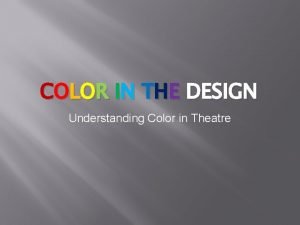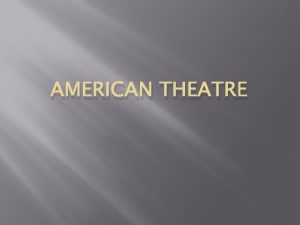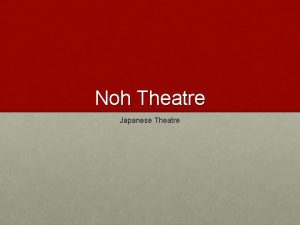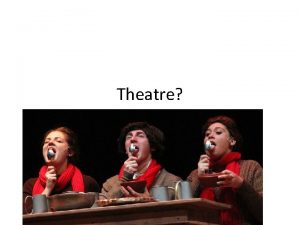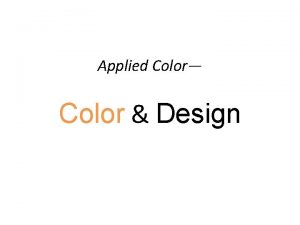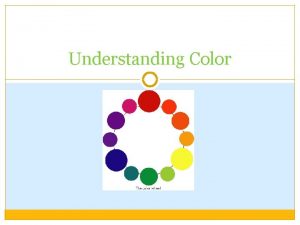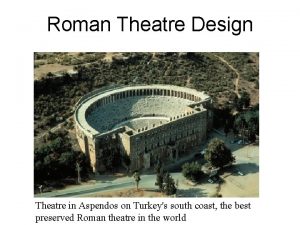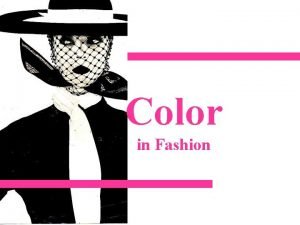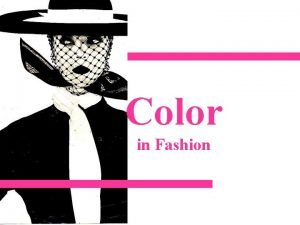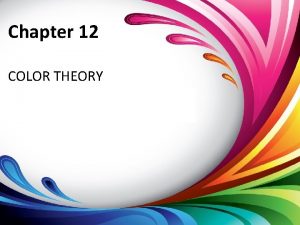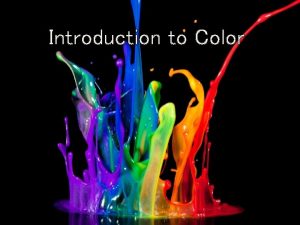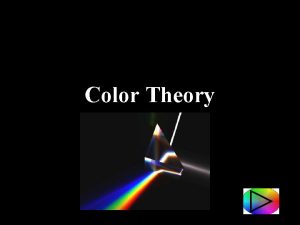COLOR IN THE DESIGN Understanding Color in Theatre








































- Slides: 40

COLOR IN THE DESIGN Understanding Color in Theatre

Introduction What this unit is all about

Color is in the eye, for no two people see color the same way and some are color-blind! Color is light! Color is paint; light merely reveals it! Color is in the mind – after all, people can dream in color!

It’s ALL of that stuff! Scenic Designer James Noone, of Boston University

We need 3 main terms to describe color in an objective way: HUE SATURATION VALUE

HUE 1. The first variation of color. 2. The position of a color in the electromagnetic spectrum. The six easily identified hues in light and pigment. PRIMARY HUES 1. The three hues which form the basis for mixing color in light and pigment. 2. In light: red, blue, green. 3. In pigment: red, yellow, blue. SECONDARY HUES 1. Hues produced by mixing any pair of primary hues.

VALUE 1. The second variation of color. 2. The light-to-dark ratio of a hue or mixed color. TINTS SHADES Used by painters more than lighting designers, in part because in colored light there is no “black” – just the absence of light. The main limiting factor in a value scale is the eye’s ability to perceive differences between steps in the scale.

White High Light Low Light Medium High Dark Low Dark See Color Plate 8 -2 in text for integration of hue and value. Black

SATURATION 1. The third variation of color. 2. The amount or percentage of a hue in a color mixture. 3. Sometimes known as “chroma” or “intensity. ” NEUTRAL means GRAYSCALE. See Color Plate 8 -3 in textbook for how this works…


PIGMENT 1. The coloring agent in paints, dyes, and nature. 2. The chemical properties that create hue. Indigo plant Madder plant various ochres

Color in Paint Without a light source, there is no visible color! A colored surface reflects only the colors of that surface, i. e. a red surface will reflect red light and absorb all others. Because we must use subtractive mixing for these mediums of color, instead of six principal hues we use twelve. Using twelve full-intensity hues allows an artist greater versatility when mixing and reduces neutralization that occurs in subtractive mixing.

COLOR CHORDS MONOCHROMATIC One color, across the entire value scale. ANALOGOUS Three neighboring hues. SPLIT COMPLEMENT Avoids direct contrast by using softer hues COMPLEMENTARY Direct opposites on the color wheel

Light & Color A little review…

Light A small part of the electromagnetic spectrum; white light is broken up into the spectrum of visible light, often thought of as a rainbow.

Pigment The substance in an object that absorbs different colors of light, giving the object its apparent color.

Primary Colors The three basic colors that form the basis for the color wheel.

Subtractive Mixing Crossing or combining of color mediums in front of a single source of light, used for painting, primary colors are RYB.

Additive Mixing Blending of colored light from two or more sources of light, used for lighting, primary colors are RGB

Lighting Instruments Leko, Fresnel, Scoop, Cyc,

Ellipsoidal/Leko/Source 4 A lamp with a hard-focus, used to send a defined beam of light over a long distance.

Fresnel A lamp with a soft-focus, used for short distances.

Scoop A lamp with a soft-focus, used at short distances to light a large area.

Cyc/Bank Light Rectangular scoops used to light the cyclorama.

Follow Spot Creates a concentrated beam of light, used to highlight specific performers on stage. The beam of light can be controlled in two ways: color and size.

Tools of the Trade What you need to work with lights!

Gloves Cotton vs. Leather � Cotton gloves are used for changing lamps (light bulbs) in lighting instruments. Who remembers WHY from the safety unit in the beginning of the year? ? ? • Leather gloves are used when focusing lighting instruments. The lights get very hot, very quickly, and these will help to protect your hands from burning!

Wrench A tool for gripping and turning the head of a nut or bolt.

LOOK AT THE DIFFERENCE! Pipe Clamp C-Clamp Type of clamp used to attach lighting instruments to pipes/battens. NOT to be used to attach lighting instruments to pipes/battens!

Safety Cable A metal cable that can be clipped to itself in a loop.

Color Gel A transparent, colored material used to change the color of the light from a lamp. Modern gels are thin sheets of polycarbonate or polyester. Require a special frame to be used, depending on the type of lighting instrument you are working with.

Gobo Metal disks inserted into ellipsoidal/Leko instruments to create unique patterns of light on stage. Require a special frame to be used.

Barn Doors Metal shutters which allow you to control the shape of a beam of light, especially on Fresnels.

Places to Know Where all this stuff goes…

Control Booth Where the dimmer board lives. NO FOOD OR DRINKS HERE, EVER!! You must be certified to use this equipment!

Catwalk Walking area above a stage where lamps are hung.

Battens Pipes on which lighting instruments are hung, specifically when a dimmer control panel is present (these connect the lights to the control board in the booth).

Lighting Trees Different heights & widths allow for extra lighting. These are usually used on the side of a stage (as shinbusters or overhead lights) or in places where battens/catwalks do not exist.

Basic Safety The DO’s and DON’Ts of Lighting

SAFETY RULES � The catwalk is not a place to play! Minimum of 2 persons and no more than 6 on the catwalk at any given time. You should never be on the catwalk without permission! � LIGHTS ARE HOT. THEY CAN AND WILL BURN YOU. � Wear gloves when working on lights: cotton for changing lamps, leather focusing. ALWAYS hang a lighting instrument with a safety cable. � � � You must be certified to use scaffolding. NEVER move scaffolding while someone is on it!!! Gels & gobos are expensive – do not play with them or cut them into “fun” shapes!
 Color in theatre
Color in theatre Hát kết hợp bộ gõ cơ thể
Hát kết hợp bộ gõ cơ thể Lp html
Lp html Bổ thể
Bổ thể Tỉ lệ cơ thể trẻ em
Tỉ lệ cơ thể trẻ em Voi kéo gỗ như thế nào
Voi kéo gỗ như thế nào Chụp tư thế worms-breton
Chụp tư thế worms-breton Chúa sống lại
Chúa sống lại Các môn thể thao bắt đầu bằng tiếng chạy
Các môn thể thao bắt đầu bằng tiếng chạy Thế nào là hệ số cao nhất
Thế nào là hệ số cao nhất Các châu lục và đại dương trên thế giới
Các châu lục và đại dương trên thế giới Cong thức tính động năng
Cong thức tính động năng Trời xanh đây là của chúng ta thể thơ
Trời xanh đây là của chúng ta thể thơ Mật thư anh em như thể tay chân
Mật thư anh em như thể tay chân 101012 bằng
101012 bằng Phản ứng thế ankan
Phản ứng thế ankan Các châu lục và đại dương trên thế giới
Các châu lục và đại dương trên thế giới Thơ thất ngôn tứ tuyệt đường luật
Thơ thất ngôn tứ tuyệt đường luật Quá trình desamine hóa có thể tạo ra
Quá trình desamine hóa có thể tạo ra Một số thể thơ truyền thống
Một số thể thơ truyền thống Cái miệng bé xinh thế chỉ nói điều hay thôi
Cái miệng bé xinh thế chỉ nói điều hay thôi Vẽ hình chiếu vuông góc của vật thể sau
Vẽ hình chiếu vuông góc của vật thể sau Biện pháp chống mỏi cơ
Biện pháp chống mỏi cơ đặc điểm cơ thể của người tối cổ
đặc điểm cơ thể của người tối cổ Ví dụ giọng cùng tên
Ví dụ giọng cùng tên Vẽ hình chiếu đứng bằng cạnh của vật thể
Vẽ hình chiếu đứng bằng cạnh của vật thể Phối cảnh
Phối cảnh Thẻ vin
Thẻ vin đại từ thay thế
đại từ thay thế điện thế nghỉ
điện thế nghỉ Tư thế ngồi viết
Tư thế ngồi viết Diễn thế sinh thái là
Diễn thế sinh thái là Dot
Dot Bảng số nguyên tố
Bảng số nguyên tố Tư thế ngồi viết
Tư thế ngồi viết Lời thề hippocrates
Lời thề hippocrates Thiếu nhi thế giới liên hoan
Thiếu nhi thế giới liên hoan ưu thế lai là gì
ưu thế lai là gì Sự nuôi và dạy con của hươu
Sự nuôi và dạy con của hươu Khi nào hổ con có thể sống độc lập
Khi nào hổ con có thể sống độc lập Hệ hô hấp
Hệ hô hấp
